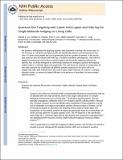Quantum Dot Targeting with Lipoic Acid Ligase and HaloTag for Single-Molecule Imaging on Living Cells
Author(s)
Liu, Daniel S.; Phipps, William S.; Loh, Ken H.; Howarth, Mark; Ting, Alice Y.
DownloadTing_Quantum dot.pdf (1.156Mb)
OPEN_ACCESS_POLICY
Open Access Policy
Creative Commons Attribution-Noncommercial-Share Alike
Terms of use
Metadata
Show full item recordAbstract
We present a methodology for targeting quantum dots to specific proteins on living cells in two steps. In the first step, Escherichia coli lipoic acid ligase (LplA) site-specifically attaches 10-bromodecanoic acid onto a 13 amino acid recognition sequence that is genetically fused to a protein of interest. In the second step, quantum dots derivatized with HaloTag, a modified haloalkane dehalogenase, react with the ligated bromodecanoic acid to form a covalent adduct. We found this targeting method to be specific, fast, and fully orthogonal to a previously reported and analogous quantum dot targeting method using E. coli biotin ligase and streptavidin. We used these two methods in combination for two-color quantum dot visualization of different proteins expressed on the same cell or on neighboring cells. Both methods were also used to track single molecules of neurexin, a synaptic adhesion protein, to measure its lateral diffusion in the presence of neuroligin, its trans-synaptic adhesion partner.
Date issued
2012-11Department
Massachusetts Institute of Technology. Department of ChemistryJournal
ACS Nano
Publisher
American Chemical Society (ACS)
Citation
Liu, Daniel S., William S. Phipps, Ken H. Loh, Mark Howarth, and Alice Y. Ting. “Quantum Dot Targeting with Lipoic Acid Ligase and HaloTag for Single-Molecule Imaging on Living Cells.” ACS Nano (December 5, 2012): 11080-11087.
Version: Author's final manuscript
ISSN
1936-0851
1936-086X